|
The UK's First
Hydrogen Powered HQ

“In any moment of decision the best thing you can do is the right thing, the next best thing is the wrong thing, and the worst thing you can do is nothing.”
Theodore Roosevelt
After years of leasing warehousing and adjoining offices, January 2019 began in earnest with a conservative effort to explore building our own HQ. I identified a rural plot of land (circa 1.5 acres) which became available for sale. The adjoining field (some 3 acres) caught my attention too – sparks of creativity started a wave of enthusiasm, which I rode (I'm still on it!). Within the blink of an eye, a price was agreed with the landowner, subject to receiving full planning permission from our local council.
Regrettably, Ashford Borough Council rejected our wonderful project however, and after an evening in front of the planning committee who overwhelmingly voted in our favour, we received the thumbs-up. Huge kudos must go to our excellent architects, Hollaway, who are not only great at designing practical, yet beautifully architectural buildings, they understand commerciality, planning and prefer to see their projects transform into a physical structure.
The shock exit of leaving the EU and the arrival of the Covid pandemic caused concern – much concern if I am to be honest. Inevitably, the project was well over budget which added to the layers of nervous complexity. Ultimately, and I believe correctly, I halted the project despite spending close to £500,000 – I remain satisfied with this decision despite strong E commerce sales throughout the various pandemic lockdowns.
At the beginning of October 2021, I called for a meeting with our architects to discuss how to rejuvenate the build, and how we can reduce the overall cost. Essentially, the teams were committed, and the detailed plans were ready for the build. Yet, I wanted to reduce the cost by £2 million which is a tall order, and without distracting from the size, the beauty and practicality. To cut three-months short, the materials used for the main super-structure must change, which they have. Of course, the entire structural calculations / design changed (as did the drawings from our MME consultants and the detailed drawings from our architects), all of which incurred more costs however, these costs should be offset against the total build development.
Our new HQ is beautiful, but and with my commercial purse bashing me around the head, it was never going to be cheap. Despite the major structural overhaul and best endeavours from everyone involved in this project, we stand around £4.5 to £4.75 million which is an enormous sum of money. Nonetheless, and to follow in Roosevelt’s words “In any moment of decision the best thing you can do is the right thing, the next best thing is the wrong thing, and the worst thing you can do is nothing” we are fully committed, and work has commenced. We plan to open early Summer 2023 which is a tight schedule but perfectly achievable…
I thought it would be nice to share all the detail, the commerciality behind the build and what to expect when you visit our new home…
Green Matters
The Vision & The Way Forward
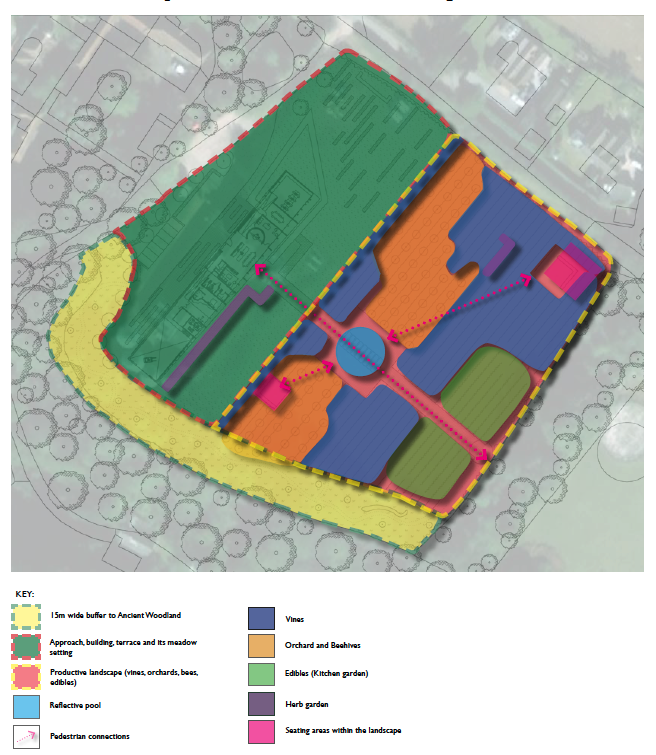
To enrich the working lives of my team, as I firmly believe that environmental factors have a greater influence on our behaviour (both at work and home) than we consider. For example, when a person achieves academic or commercial success, is this because they are genetically predisposed to be successful or is it a result of an enriched environment? To a degree, both, however an enriched working environment, a setting which you love to be part of will undoubtedly bring the best out of a human being.
We will farm organically – all spraying is vetoed which is critical to our beehives which we will nurture onsite. We will promote a healthy ecosystem and encourage larva of ladybirds, hoverflies and lacewings, which consume aphids. Without these predators in our landscape, pests like aphids, which breed very rapidly, can quickly get a hold and damage crops. With a healthy ecosystem there will always be a balance, however with predators keeping their prey under control. Bats, birds, frogs and toads are all great predators too, and will be actively encouraged to make their home with us…
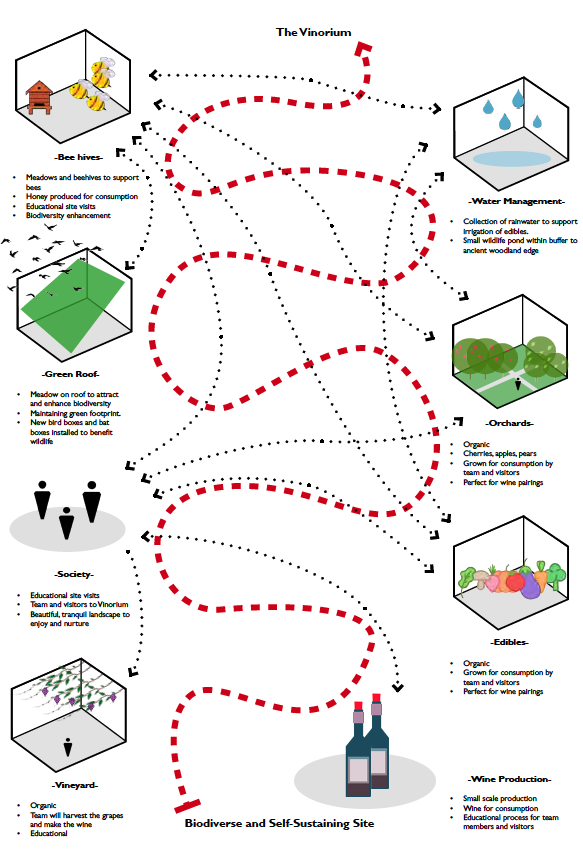
No Compromise: Going Off-Grid
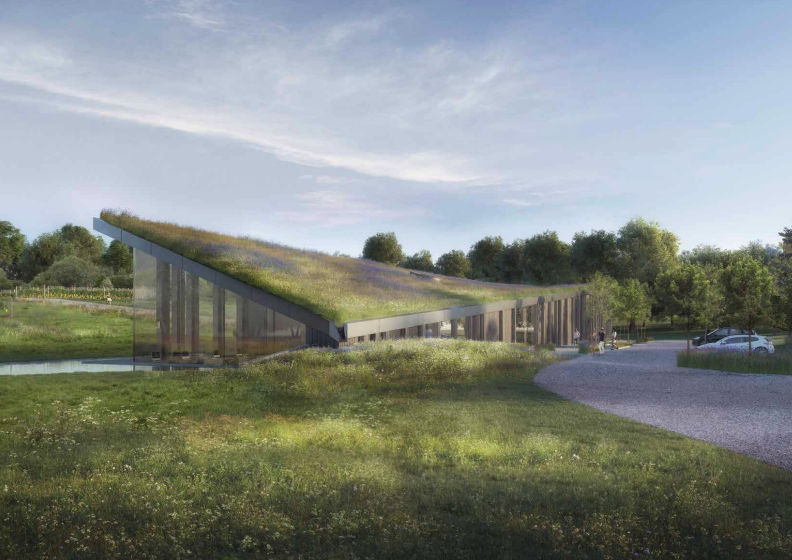
Our Sky Meadow: Our 1,000 square-metre wild sky meadow roof system is both beautiful and incredibly important as it offers undisturbed habitat for wildlife. The thermal mass of the thick meadow retains coolness during the summer months and retains warmth during the winter, which is a fabulous benefit as is storm water management / rainwater harvesting. As we are now witnessing, and far too frequently, flooding is a serious problem in the UK. Impervious surfaces such as slate, concrete or waterproof membranes direct rainwater rapidly into drains, causing a surge in water flow which many of our current systems cannot cope with.
Instead of digging a 450-metre trench and connecting to mains water, we have taken the decision to function without the need. To compensate, rainwater will be directed from the large roof which will be collected in our natural pond (some twenty metres in length). The main office area is below ground level with the pond wrapping around all the large, office windows creating an infinity pool-like feel for the team. Air-conditioning is not required as I plan to harness the cooling nature of water, and reason for the large scale, natural pond. I am hoping that air will flow from high to low pressure and that will create a gentle, cooling breeze during the summer months, thus making it feel cooler when working along the ponds edge. Special windows will open allowing the team to benefit from the breeze.
The pond will be planted with oxygenating and cleansing plants making it ideal for wildlife and for the team if they fancy a swim in the natural pond. Rainwater from the pond will be directed to our underground filtration system, cleaned / sanitised and directed into the building for use. All wastewater (including toxic water from our winery) will be processed through our underground Bio-Bubble reactors resulting in clean water being released underground, and daily.
Heating and cooling: We harness the heat from the ground via our huge ground source heat pump, which weaves underground and between each row of vines.
Hydrogen Power, and the First in the UK
Our system specification will allow The Vinorium to operate completely off grid, all year round. All electricity cables and two pylons are currently being removed by UK Power Network – there are no electricity backups which makes this aspect of the project (along with our clean water generation) so, so exciting.
Our system includes a small solar field, with approximately 100 panels, one Li Ion battery to take the load fluctuations, one electrolyser, multiple hydrogen storage tanks and a fuel cell. The system will intelligently direct the solar energy where it is best utilized. When the building is drawing power, direct solar energy is best, same to the heat pump when heating is required. When there is excess solar not being used, hydrogen will be produced and stored. In the winter or during the night, when solar production is low or zero, the system will use the stored hydrogen to power the facility and if required, the heat pump.
How it works - main components
Energy not used or stored for short term demand will be sent to the electrolyser for conversion to hydrogen. The electrolyser uses the ‘available’ electricity to split water into Hydrogen and Oxygen. HydroGenesis use AEM electrolysers that transport hydroxide ions (OH --) through an electrolyte from the cathode to the anode with hydrogen being generated on the cathode side.
The hydrogen is collected then compressed and stored in large cylinders until electricity is required.
A hydrogen fuel cell takes hydrogen in at the anode and oxygen at the cathode. The hydrogen atoms are stripped of their electrons (negatively charged subatomic particles) via oxidation at the anode, achieved via a catalyst, and these are forced to do “work” around an electrical circuit. The protons (positively charged subatomic particles) are almost 2000 times smaller than the electrons and are able to pass through the membrane. The protons and electrons reunite at the cathode and react with the oxygen in a reduction reaction which creates water (specifically 2H20).
Our Aussie Vineyard in the UK
Our vineyard will be planted with rootstocks harvested from our cool-climate Australian producers (Tasmania, Victoria, Macedon Ranges, Margaret River and the like). This represents the UK’s first and a major trial for the UK wine growing sector, which I am excited to lead. We aim to plant 16-blocks, each block representing a single varietal / clone from one producer. Once the vines have matured, we aim to invite one of our Aussie winemakers over and let them loose on producing wine. They have complete artistic freedom – they can blend blocks together, produce single block wines or a combination of both. Our aim is to produce stunning ‘still’ wine rather than sparkling. Time will tell with our first harvest due 2026 / 2027…
Food for our Plates
An abundance of organic fruit and vegetables will be grown which will provide the mainstay for all our team lunches and events. I live on the edge of acre-upon-acre of apple orchards. Sadly, the old gnarly trees are now being grubbed-up as their production levels are no longer sustainable however, what I will miss the most is the long lines of asparagus which pop-up amongst the tree lines. Clearly, the fruit farmer of old used the space wisely. This got me thinking – I now plan to grow a few rows of asparagus amongst my vines. Both take circa four-years to bear quality.
I also plan to ‘companion grow’ the following between the rows of vines: Nasturtium, Clover (increases soil fertility), Chamomile, Coriander, Dill, Fennel, Basil, Hyssop and Garlic – Most make for fabulous eating and great for the pollinators. We border an ancient woodland, where I am looking forward to foraging. I also plan to grow Comfrey along the borders - I have plenty at home. Comfrey is the organic gardener's best friend. Its leaves are full of nitrogen, phosphorus and potassium - all nutrients needed by growing plants. Comfrey makes amazing fertiliser, and it’s free…
Cooking will feature heavily as will the method(s). Indoors, we have an enormous, sunken, open fire pit which will seat at least a dozen people. Warming by an open fire during winter days will be wonderful however, I am looking forward to rigging-up a grill / stand system for woodfire cooking. Similarly, we will have an woodfired oven somewhere in the grounds…
The kitchen is huge and has been designed to entertain – The professional kitchen will accommodate at least 3-4 chefs who will take produce from our garden and cook onsite. Protein will be brought in, although I am keen to utilise the abundance of local rabbits and game birds – squirrel too…
We plan to host press and private client events – long mornings / afternoons spent sampling our wines followed by a sumptuous meal prepared by our team of chefs who we are now consulting with (Including local Michelin starred chefs and MasterChef Professional finalist, Matt Willdigg. Matt is passionate about foraging, and now runs his own catering company, Foray Catering.
Our winemaker lunches / dinners have been non-existent, which will change upon opening. 2023 - We will plan a series of events with many of our Aussie wine producers who will guide you through their wines, followed by a great meal prepared on-site. We have a very local, and smart country hotel which alleviates any problems with getting home.
Our Very Own Bonded Warehouse
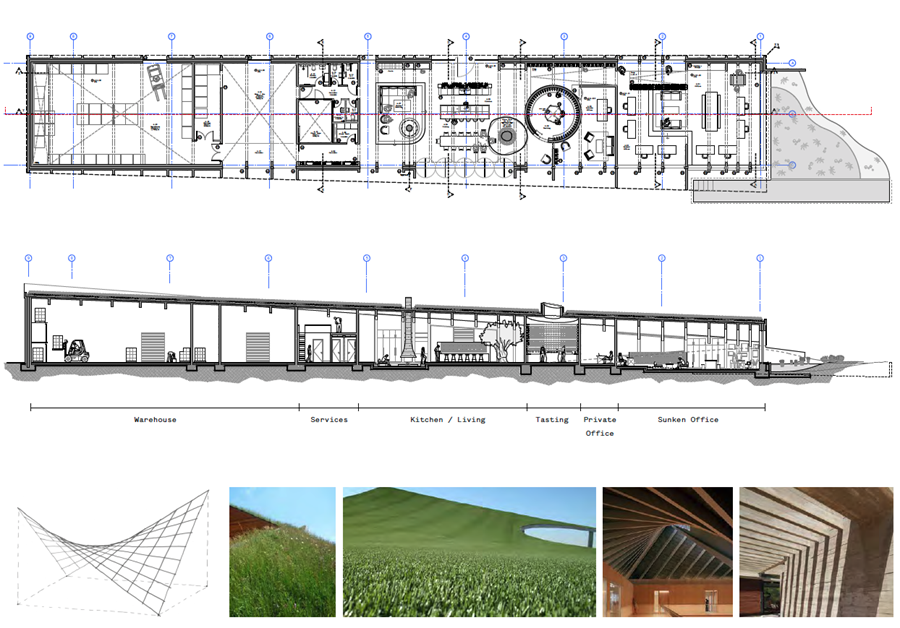
Currently, we use a third-party bonded warehouse (London City Bond) which incurs an annual cost of approximately £45,000. We also store approximately 18,000 bottles within our ‘customer storage account’ at LCB. Storing these within our own bonded facility will generate an immediate income stream of circa £20,000 per year with the expectation that this will continue to grow year on year as our customer base grows. Providing this storage facility ourselves also creates additional sales opportunities as all services and sales can be offered ‘in house’ as a complete package to customers.
Our current HQ warehouse is home to circa 20,000 bottles. The downside being that we have prepaid duty and VAT on each bottle – our annual cost being circa £111,000. This is a substantial sum of money to absorb and can be negated. The global shipping crisis is well documented and the universal opinion being that 1. We will not see any changes to the broken service 2. Shipping delays of 2-3 months will continue until early 2023 and 3. The huge price increases which we have endured (some 130%) will not ease until 2025 / 2026.
This is compounded by the lack of UK hauliers and port workers who are not clearing containers quick enough, resulting in further delays of 3-4 weeks. Currently, we are unable to split our shipments resulting in full loads being directed to London City Bond. Again, we wait for our orders to be unloaded, checked and landed on HMRC’s system. Each case receives a charge. Stock destined to our HQ warehouse must be redelivered by London City Bond, resulting in further costs. The entire process is extremely slow, convoluted and incredibly expensive. Our new HQ will house our own bonded warehouse. Capacity sits at 100,000 bottles which covers our existing (duty paid and under bond) stocks together with sufficient growth. The benefits are overwhelming:
• Enormous cost savings as we will not require the services of London City Bond.
• Speed. We can accept deliveries from the UK ports anytime of the day and at a moment’s notice – this will save at least 3-4 weeks compared to London City Bond.
• Our duty paid stocks will be kept to a minimum which provides a huge uplift in our cash flow. Our new ecommerce platform has been designed to operate our own bond and to automatically move under bond stocks into a duty paid state when we set a threshold (in terms of bottle numbers) on each SKU. This is an automatic process which operates 24 hours a day, seven day per week.
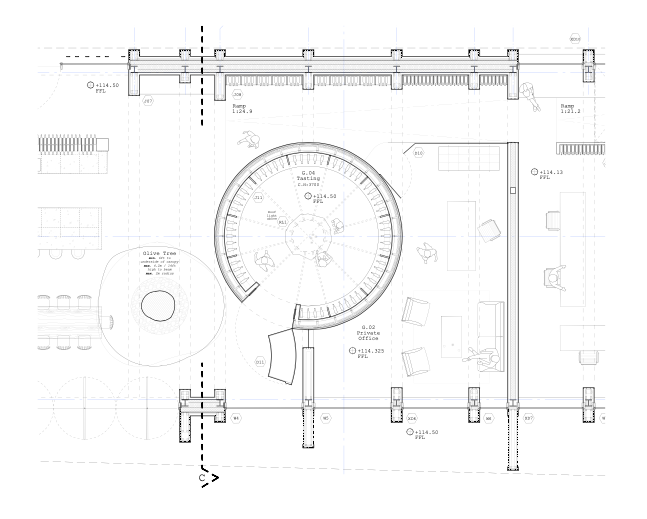 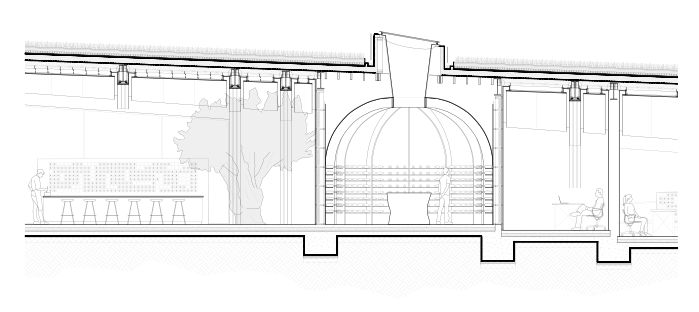
And to our pièce de résistance – our fully enclosed sensory tasting room which, and from the outside, appears in the form a vertically clad (Siberian larch) silo, giving a nod to the former building. The room stretches to the ceiling – the internal diameter covers 5 metres which provides a sense of space and a degree of intimacy. What to do with the internal space has been a point of continued conversation for well over a year. A solid bolder weighing many tons will be lowered in by crane and will sit centre to the room – the surface will be polished and provide the platform for wine tasting. The exterior of the bolder will be left gnarly and untouched. Directly above the table is a sky dome which peers above the wild grass meadow – A column of natural light will be directed into the tasting room casting an atmospheric optical beam of light onto the tasting table. The remainder of the room will remain shaded, and in the dark.
Solid fins of wood will stretch from the floor and meet at the centre point. Each fin will be graduated – narrow from the floor and elegantly arching to full thickness at the beam of light. My aim is to provide a cathedral like feel to the room. Bespoke shelves (gently curving to follow the movement of the room) will sit between each fin – the room will accommodate thousands of bottles of wine which will stretch the full of height of the room. This has the entire team jumping with excitement…
Our garden and headquarters are designed to be a safe and protective home for our chosen charity(s) who are able to use the entire space for exploration, reflection, relaxation and therapy. Every aspect of the design is considered from wheelchair accessibility to age and special needs.
Our aim is to open our working garden to local schools – what better way to connect to nature and recognise ecology and science on a tangible level. Our soil to plate programme will work closely with one, chosen charity. The selected charity will spend an entire year working with The Vinorium team for vineyard and viticultural days, planting seeds, potting on to finally harvesting the labour of their hard work. Conventional and woodfired ovens (both internally and externally) will be the tools to cook the bounty of our weekly harvests – everyone will join in – cook together, eat together and create long and cherished memories.
The Vinorium focus is on long-term strategies for making a positive impact economically, socially and environmentally. For us, sustainability is about framing our business decisions in terms of decades and considering all factors rather than just the financial benefit. We have considered the impact for future generations and life at The Vinorium in 2040. Recycling, biodegradable packaging and shipping are merely a small contribution but we acknowledge, an important one. We have partnered with other businesses for sustainability enterprises and hope that our joint actions are to solve climate change complications. Turning a blind eye to inappropriate business practices whilst offsetting one’s carbon footprint is something that should not be celebrated… This is just the beginning, and I do hope you are as excited as my team and I. Of course, I will keep you all updated as our development progresses.
Cheers,
Stu
Gallery
Pre demolition of the grain store & demo in progress (now complete)
|
